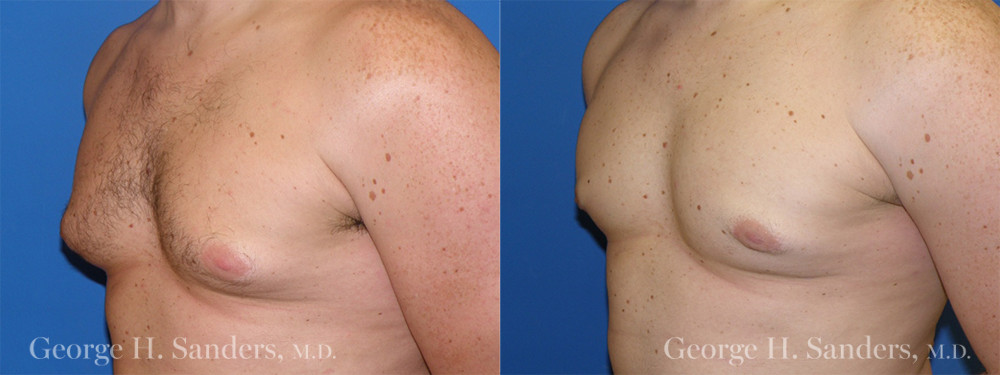Gynecomastia typically first appears during puberty. While this condition normally disappears by the time a boy reaches adulthood, in some cases the excess breast tissue persists. In addition, the use of certain medications, such as antidepressants, high blood pressure drugs and anabolic steroids has been linked to overdeveloped male breast tissue.
The Gynecomastia Surgery Procedure
Regardless of the exact cause of gynecomastia, this condition can be resolved through male breast reduction surgery. As a highly experienced gynecomastia surgeon, Dr. Sanders uses two techniques to eliminate the excess tissue – liposuction for fat removal and/or removal of breast tissue, sometimes with the use of special surgical instruments.
The instruments include a motorized shaving device that allows for the removal of the gynecomastia via one of the small liposuction incisions, avoiding the need for a longer incision around the areola with postoperative drains. In certain cases, he also removes the excess skin to create a contoured, masculine chest appearance. Gynecomastia surgery typically requires two hours to complete, and most patients are able to resume their usual daily activities within one week.


Dr. Sanders’ Process for Gynecomastia Surgery
The first step for anyone seeking gynecomastia surgery is to schedule a consultation with Dr. Sanders. During this consultation, he will ask you about your medical history, what medications you take, and your goals for the procedure. He will then examine your breasts to see the extent of the problem.
If you are a good candidate for the procedure, Dr. Sanders will explain how to prepare and what to avoid (i.e., taking blood-thinning medications and drinking alcohol) before surgery. Dr. Sanders may use liposuction and sculpting with special instruments to eliminate excess male breast tissue.
He begins by administering the necessary anesthesia, followed by removal of excess fat with liposuction. Breast tissue is then removed via a ⅛ inch long incision around the areola and drains are not required. If there is a need for more breast tissue removal, the incision can be lengthened, but it is usually very difficult to detect after surgery. Occasionally a small drain is needed that is usually removed the next day.In some instances, Dr. Sanders removes excess skin to give you a more contoured look. For most men, the procedure takes about two hours.
Recovery After Your Procedure
There is not a considerable amount of downtime associated with gynecomastia surgery that you have to worry about. However, you still want to take some time to rest during the first week. You will wear a supportive garment that will help with healing.
Avoid taking blood-thinning medications and drinking alcohol, as these substances may affect your recovery. You must avoid strenuous exercise, but you can go on short walks to keep your blood flowing normally.
Showers are not a concern because you can get the stitches wet, but you should try to keep the area from coming into contact with harsh chemicals. Dr. Sanders also recommends waiting at least three days before you start driving again.
After about two weeks, you can return to light exercise.. Still, you will likely need to wait one month before engaging in weightlifting or other highly strenuous activities.
Gynecomastia Frequently Asked Question
-
Can Gynecomastia Be Effectively Treated Without Surgery?
While surgery is an excellent option to treat men with gynecomastia, it is not the only option. Dr. Sanders may recommend an alternative approach if a man is not healthy enough for gynecomastia surgery. Some of these approaches include:
- Hormone therapy. Gynecomastia is often caused by a hormonal imbalance, so sometimes, by lowering the levels of estrogen in a man’s body, it can stop breasts from growing.
- Reducing the intake of certain drugs. Sometimes, men who take blood pressure medication, anabolic steroids, Propecia, and other medications can develop gynecomastia. Stopping these drugs may stop breast tissue from growing.
- Treating underlying conditions, such as cirrhosis, hyperthyroidism, disorders of the testes, prostate cancer treatments, or kidney disease.
- For most men, however, gynecomastia surgery represents the best treatment for the condition.
- How Can Gynecomastia Surgery Improve a Man’s Confidence?
- When Can I Return to Work After Gynecomastia Surgery?
- When Can I Go Back to My Normal Workout Routine After Gynecomastia Surgery?
- How Long Will My Results Last?
- Is Getting Surgery for Gynecomastia Really Worth It?
Excellence in Gynecomastia Surgery in Encino
When you visit Dr. Sanders for gynecomastia surgery in Encino, CA, you choose a board-certified plastic surgeon with years of experience achieving natural-looking results. For more information on gynecomastia surgery, please contact Dr. Sanders’ office to schedule a consultation.

